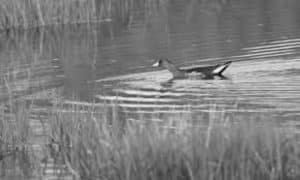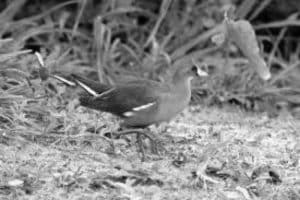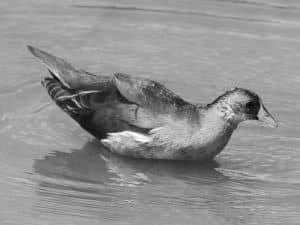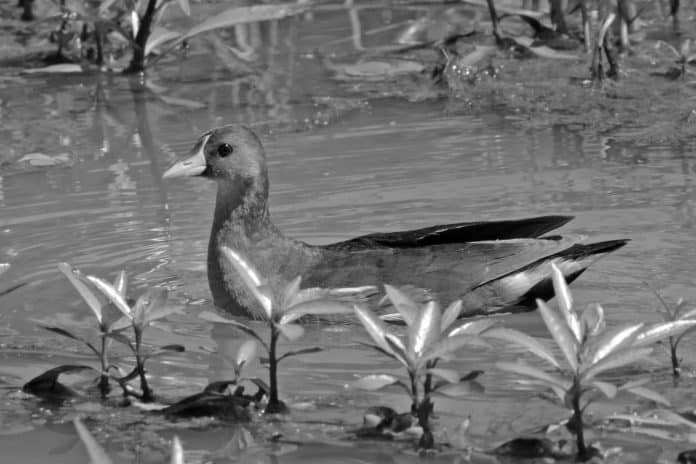Introduction to the lesser moorhen in Tanzania
The lesser moorhen (Gallinula angulata), also known as the African gallinule or waterhen, is a small waterbird that inhabits the wetlands of Tanzania. These fascinating creatures are often overlooked due to their diminutive size, but they play a crucial role in the delicate balance of the wetland ecosystem. In this article, we will delve into the habitat, physical characteristics, behavior, threats, and conservation efforts related to the lesser moorhen in Tanzania.
Habitat and distribution of the lesser moorhen

The lesser moorhen is primarily found in the wetlands of Tanzania, where it thrives in a variety of aquatic habitats such as marshes, swamps, and shallow lakes. These areas provide the ideal environment for the moorhen’s feeding and breeding habits. They are particularly abundant in the northern regions of Tanzania, including the Serengeti National Park, Lake Victoria, and the Selous Game Reserve.
Physical characteristics and unique adaptations
Measuring only about 30 centimeters in length, the lesser moorhen is a small bird with a distinctive appearance. It has a dark plumage with a bluish-grey undertone, a red frontal shield on its forehead, and a white undertail. Its beak is bright red, and its legs and feet are long and yellow. These physical characteristics allow the lesser moorhen to blend seamlessly into its wetland surroundings.
One of the unique adaptations of the lesser moorhen is its ability to walk on floating vegetation. It has long toes that distribute its weight evenly, preventing it from sinking into the water. This adaptation enables the moorhen to access areas of the wetland that other birds may not be able to reach, giving it an advantage in foraging for food and nesting.
The moorhen also possesses a specialized beak that is perfectly suited for its omnivorous diet. It can feed on a variety of food sources, including aquatic plants, seeds, insects, and small invertebrates. This adaptability allows the lesser moorhen to survive in the ever-changing wetland ecosystem.
Lesser moorhen behavior and mating rituals
The lesser moorhen is a social bird that often forms small groups or pairs. These groups are territorial and vigorously defend their nesting sites from intruders. They communicate through a series of calls, including sharp “ki-ki-ki” sounds and soft croaking noises.
During the breeding season, the male lesser moorhen engages in an elaborate courtship display to attract a mate. This display includes spreading its wings, puffing up its feathers, and bobbing its head. Once a pair is formed, they build a nest together using materials such as reeds, grass, and twigs. The female typically lays a clutch of 4-8 eggs, which both parents take turns incubating for approximately 20-22 days.
Threats and conservation efforts for the lesser moorhen

Despite their importance in the wetland ecosystem, lesser moorhens face several threats to their survival. Habitat loss due to human activities, such as land conversion and drainage of wetlands, is a significant concern. Pollution from agricultural runoff and invasive species also pose challenges to their well-being.
To address these threats, various conservation efforts are underway in Tanzania. These include the establishment of protected areas and wetland conservation projects. Additionally, raising awareness about the importance of wetlands and their inhabitants, such as the lesser moorhen, is crucial in ensuring their long-term survival.
Lesser moorhen in the wetland ecosystem
As a key species in the wetland ecosystem, the lesser moorhen plays a vital role in maintaining the delicate balance of these habitats. They contribute to nutrient cycling by consuming plant matter and invertebrates, and their droppings enrich the surrounding soil. They also serve as prey for larger predators, such as birds of prey and crocodiles, further supporting the intricate web of life in the wetlands.
Lesser moorhen sightings and birdwatching opportunities in Tanzania
For birdwatching enthusiasts, Tanzania offers rich opportunities to observe the lesser moorhen in its natural habitat. The wetlands of Serengeti National Park and the Selous Game Reserve are particularly renowned for their diverse bird populations. Guided birdwatching tours are available, providing an immersive experience to witness the beauty of the lesser moorhen and other avian wonders.
Lesser moorhen research and ongoing studies
Scientific research plays a crucial role in understanding the lesser moorhen and its conservation needs. Ongoing studies focus on various aspects, including their behavior, breeding patterns, and population dynamics. By gathering data on these aspects, researchers can develop effective strategies to protect the lesser moorhen and its wetland habitat.
Lesser moorhen photography tips and tricks

Capturing the beauty of the lesser moorhen through photography can be a rewarding experience. To enhance your chances of getting stunning shots, consider the following tips and tricks:
- Use a telephoto lens to capture the moorhen’s intricate plumage details and behavior from a distance.
- Experiment with different angles and perspectives to create unique compositions.
- Patience is key – spend time observing the moorhen’s behavior to anticipate interesting moments.
- Be mindful of your surroundings and avoid disturbing the bird or its habitat.
- Take advantage of natural lighting conditions, such as early morning or late afternoon, for soft and warm tones in your photographs.
Conclusion: Appreciating the beauty and importance of the lesser moorhen in Tanzania
The lesser moorhen in Tanzania may be small in size, but it is indeed a marvel of the wetland world. From its unique adaptations to its vital role in the ecosystem, these birds deserve our attention and appreciation. By understanding the challenges they face and supporting conservation efforts, we can ensure the continued existence of these tiny marvels in the wetlands of Tanzania.

































